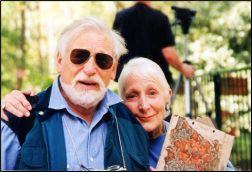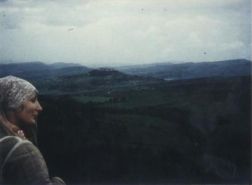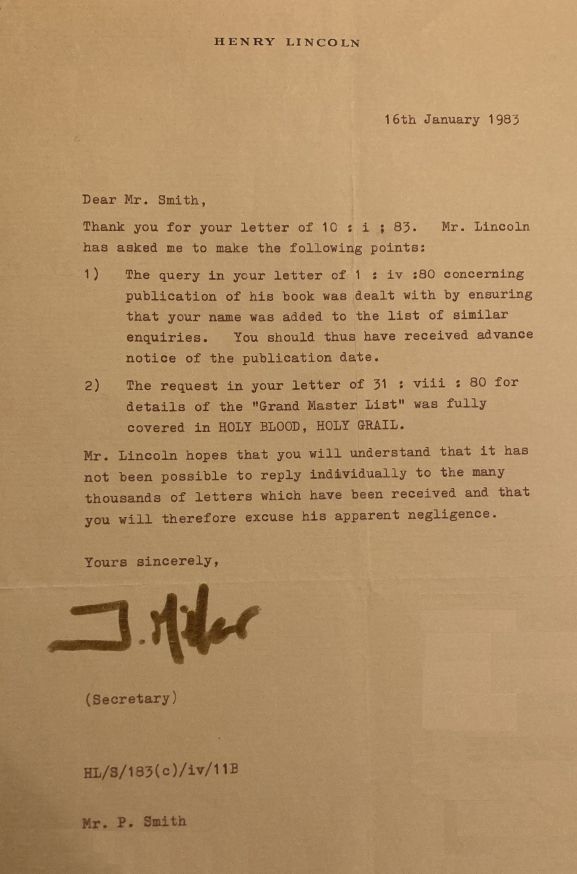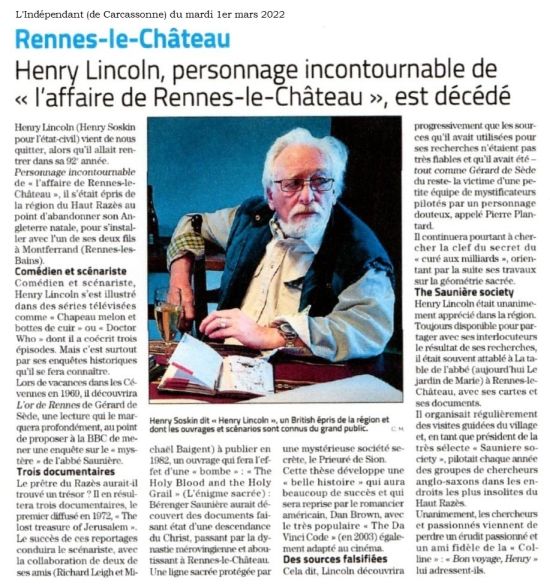|
Henry Lincoln, born Henry Soskin: one time bit actor, one time BBC screenwriter, co-screenwriter of one cinema film – came to prominence when he presented, wrote and co-wrote three “documentaries” on the alleged “mystery” of Rennes-le-Château (that have since been shown to be full of holes). Following the “documentaries”, he eventually published with two co-authors – after several refusals from various publishers – “The Holy Blood and the Holy Grail” – a conspiracy theory about the Bloodline of Jesus Christ that became the biggest Tourist Attraction to the village of Rennes-le-Château (or the “myth of the orifices” as Gérard de Sède described it). Henry Lincoln gave public lecture tours about the book's subject matter prior to its publication.

Henry Lincoln later decided to drop the Jesus Bloodline to write books about sacred landscape geometry – after being a visitor to David Wood's lectures on the subject matter at his home (but keeping the writing of his book a secret from David Wood). Following the passing of his second wife, Henry Lincoln moved to the small village of Rennes-les-Bains, and used it as a base to give tours and lectures on the conspiracy theory. Henry Lincoln subsequently called himself the “Grandfather of Rennes-le-Château”.

The appeal of the Jesus Christ Bloodline conspiracy theory has been substantial. Some New Age writers have taken the alleged marriage of Jesus Christ to Mary Magdalene and interwoven it with the Return of the Goddess and the Sacred Feminine; still other writers have used it as a platform for their novels about the dynasty of Jesus Christ.
This is continuing into the present day – mainly because of the power of the Internet carrying the voice of Alternative History on websites, social networking websites and podcasts.
A disturbing side to all of this was that Henry Lincoln – who was of Jewish origin – supported and used Pierre Plantard's mythology of the Priory of Sion to buttress his works on Rennes-le-Château. Pierre Plantard, as well as being an obvious charlatan, was a French Vichyite anti-Semite during World War Two and his Priory of Sion mythology contains elements and echoes of Right Wing Roman Catholic Theology – sometimes actually invoking the names of priests – Abbé François Ducaud-Bourget and Abbé Georges des Nantes (who founded the League for Catholic Counter-Reformation) – who resisted the liberal changes made by the Roman Catholic Church and were excommunicated (Vatican II, or the Second Ecumenical Council of the Vatican, 1962-1965).
Pierre Plantard was the total opposite of what Henry Lincoln claimed about him. Abbé Bérenger Saunière – too – was the total opposite of what Henry Lincoln claimed about him. Both Plantard and Abbé Saunière were staunch anti-Semitic Traditionalist Roman Catholics opposed to the atheistic and secular French Republic – but Henry Lincoln could not have made a livelihood for himself by sticking to the real sober and historical facts.
To sum up Henry Lincoln – he was a caricature and a parody of a “historian” who became the darling of those romantics who cherished Modern Alternative History. By allowing himself to be addicted to the “mystery” Henry Lincoln sucked himself into something that never existed.


|
From L’Indépendant de Carcassonne of Tuesday 1 March 2022.
Rennes-le-Château.
Henry Lincoln, a key figure in the ‘Rennes-le-Château affair’, has died.
Henry Lincoln (real name Henry Soskin) has passed away just as he was entering upon his 92nd year.
A key figure in the ‘Rennes-le-Château affair’, he fell so much in love with the Haut Razès region that he actually abandoned his native England to settle, with one of his two sons, in Montferrand (Rennes-les-Bains).
Actor and screenwriter.
An actor and screenwriter, Henry Lincoln made a name for himself in television series such as ‘Chapeau melon et bottes de cuir’ (‘The Avengers’) as well as ‘Doctor Who’, for which he also co-wrote three episodes. But it was mainly through his historical investigations that he would become well-known.
During a holiday in the Cévennes in 1969 he came across Gérard de Sède’s book L’or de Rennes, which left a deep impression on him to the point of him proposing to the BBC that they conduct an investigation into the ‘mystery’ of Abbé Saunière.
Three documentaries.
Did the priest of the Razès really find a treasure? Whether he did or not the result was three documentaries, the first, broadcast in 1972, entitled The lost treasure of Jerusalem. The success of these documentaries led Lincoln, with the collaboration of two of his friends (Richard Leigh and Michael Baigent), to publish a book in 1982, The Holy Blood and the Holy Grail (L’énigme sacrée), that proved to be a sensation: Bérenger Saunière was said to have discovered documents showing the descent of Christ passing through the Merovingian dynasty and ending up at Rennes-le-Château – a sacred bloodline protected by a mysterious secret society, the ‘Priory of Sion’.
This theory was the stuff of which great stories are made: it did indeed prove very successful and was taken up by the American novelist Dan Brown with the very popular ‘Da Vinci Code’ (2003), which was also adapted for the cinema.
Falsified sources.
That said, Lincoln would gradually discover that the sources he had used for his research were not very reliable and that – like Gérard de Sède indeed – he had been the victim of a small team of hoaxers led by a dodgy character called Pierre Plantard.
Nevertheless, he continued to search for the key to the secret of the ‘billionaire priest’, later turning to the subject of sacred geometry.
The Saunière Society.
Henry Lincoln was universally respected in the region. Always willing to share the results of his researches with fellow enthusiasts, he could often be found seated, with his maps and documents, at La table de l’abbé (today Le jardin de Marie) in Rennes-le-Château,
He regularly organised guided tours of the village and, every year, as president of the very exclusive ‘Saunière Society’, led groups of English-speaking researchers to the most out-of-the-way places in the Haut Razès.
Both serious researchers and enthusiasts have lost a passionate scholar and a faithful friend of ‘La Colline’. They all wish him, ‘Bon voyage, Henry’.
Photo caption: Henry Soskin, also known as ‘Henry Lincoin’, a Brit with a passion for the region, whose books and screenwriting are well known to the general public.
|
|